QBARS - v31n4 The Interesting Underside
The Interesting Underside
Arthur P. Dome, Seattle, Washington
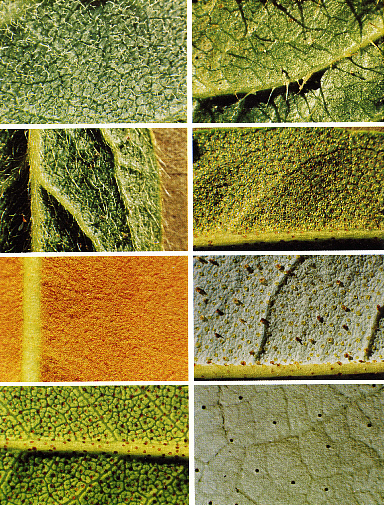
|
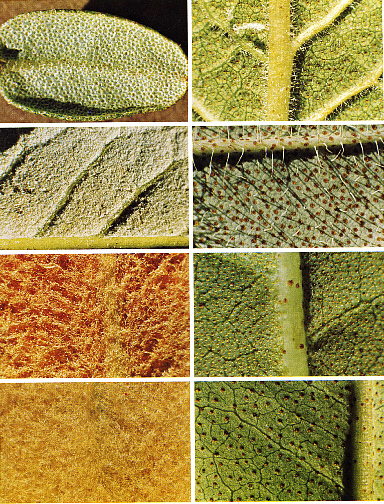
|
|||
|
auriculatum
mucronatum campanulatum campylogynum var. cremastum |
camtschaticum
kotschyi glaucophyllum genestierianum |
intricatum
sanguineum ssp. didymum haematodes yakushimanum |
spinuliferum
lepidostylum lutescens yunnanense |
|
Can you remember your thoughts or diagnosis the first time you turned a rhododendron leaf over and observed something new and unexpected? What happened to the conventional smooth green surface that was customary? With a second inquisitive look it appeared that this unusual substance or growth was actually a part of the leaf.
Depending upon the leaf it could have been scales, bristles, hairs of various types or a felty-type growth of varying degrees called indumentum. Further investigation shows us that all of these appendages have a definite place in that particular plant's structure. Also, the type and location on the plant are very important to its identification and classification. Whether a rhododendron has scales or not is usually the first determination one makes in trying to classify or identify the species. At this point we have the first division in the genus Rhododendron. Elepidote plants have no scales and lepidote plants have scales. Depending upon how involved one wants to get they can research further and find that many of these scales are different, also they have been named and classified.
I'm not sure if these scales and hairs or lack of them play any particular function in determining the plants well being or not but observing them can be quite interesting. We know that small insects can get trapped in the hairs or to the sticky substance that forms on the new growth of some plants. There doesn't seem to be too much consistency in trying to relate their natural environment to what covers their leaves.
We do know that, in many cases, the time of the year that the photograph is taken will determine the shade and color of the leaf. This can also be true about the type and amount of scales, hairs, indumentum etc. present. These pictures were taken in the late summer.
The magnification shown by these pictures will vary some. Perhaps the greatest magnification, at actual 35 mm slide size, would be 20 times. The depth of the indumentum, length of the hairs or the size of the scales all contribute to the determination. As you know one can get quite close to a smooth, hairless surface with a lens, and thus get a larger magnification that will have everything in focus. Leaf surfaces with long hairs or heavy indumentum require being further away from the subject because of a need for a greater depth of field to get everything in focus, thus there will not be so great a magnification. All of these pictures were taken out-of-doors with existing light. The lens apertures varied between f11 and f22 with the shutter speed between 1/15 second to ½ second.
The descriptions pertaining to the underside of the leaves are from the book "The Species of Rhododendron" that was edited by J. B. Stevenson. This was done to help assure a continuing uniform and accurate representation. I will not speculate as to why some of the taxonomists went into such detail with their descriptions and others were so brief. Since most folks know or have a adequate glossary of botanical terms available to them no definition or explanation of these terms has been given.
R. auriculatum , S. Auriculatum, Elepidote. "Under surface pale green, clad allover with a tomentum of isolated flexuous thread-like hairs many of which are gland-tipped, midrib very prominent, pale green, clad with long soft thread-like glands, primary veins prominently raised except towards the leaf margins."
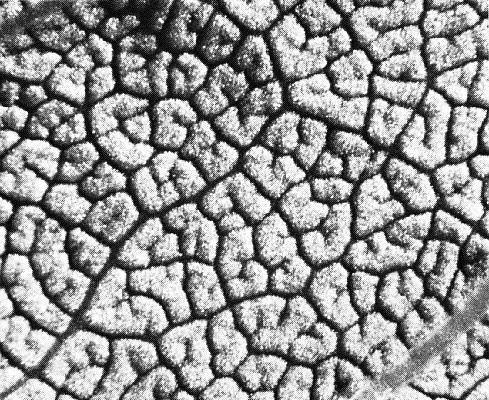
|
|
R. schlippenbachii
Photo by Art Dome |
R. schlippenbachii , s. Azalea, s.s. Schlippenbachii, Elepidote Sparsely pubescent on both sides at first, later glabrous except on the underside of the principle veins, dark green above, pale beneath."
R. mucronatum , s. Azalea s.s. Obtusum, Elepidote. "Light green, clothed on both surfaces with appressed straight and soft grey to rufous hairs."
R. campanulatum , s. Campanulatum, Elepidote. "Under-surface clad with a fawn, rusty-brown or tawny felted indumentum, midrib prominent, primary veins somewhat obscure."
R. campylogynum var. cremastum , s. Campylogynum, Lepidote. "Glabrous above, loosely scaly below with distinct lateral nerves."
R. camtschaticum , s. Camtschaticum, Elepidote. "Venation prominent, especially below, the primary veins ascending at a narrow angle, vein reticulations open, the primary veins, midrib and margin clad with setose hairs, many of which are at first gland-tipped."
R. kotschyi , s. Ferrugineum, Lepidote. "Densely scaly below, scales about half their own diameter apart or sub-contiguous."
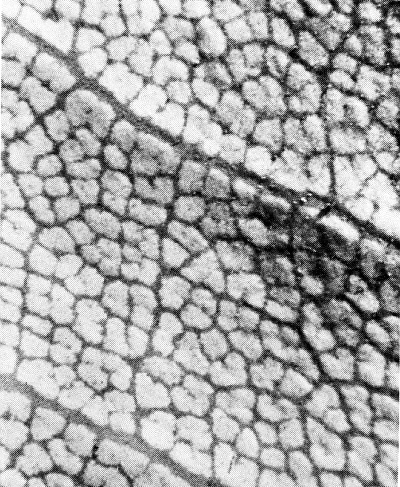
|
|
R. orbiculare
Photo by Art Dome |
R. orbiculare , s. Fortunei, s.s. Orbiculare, Elepidote. "Undersurface glaucous, papillate, to the eye glabrous but under magnification punctulate with minute hairs, midrib raised, vein reticulations conspicuous."
R. glaucophyllum , s. Glaucophyllum, Lepidote. "Glaucous below and scaly, the scales unequal, the smaller pale yellow and about their own diameter apart, with scattered larger brown scales."
R. genestierianum , s. Glaucophyllum, s.s. Genestierianum, Lepidote "Very glaucous below, glabrous above, the scales below very few and minute."
R. intricatum , s. Lapponicum, Lepidote. "Densely scaly on both surfaces, the scales below densely overlapping and greenish-grey."
R. sanguineum ssp. didymum , s. Neriiflorum, s.s. Sanguineum, Elepidote. "Undersurface clad with a persistent ash-grey indumentum."
R. haematodes , s. Neriiflorum, s.s. Haematodes, Elepidote "Undersurface densely rufous-woolly-tomentose, midrib raised, primary veins concealed by indumentum."
R. yakushimanum , s. Ponticum, s.s. Caucasicum, Elepidote. "Below very densely fuscous-tomentose."
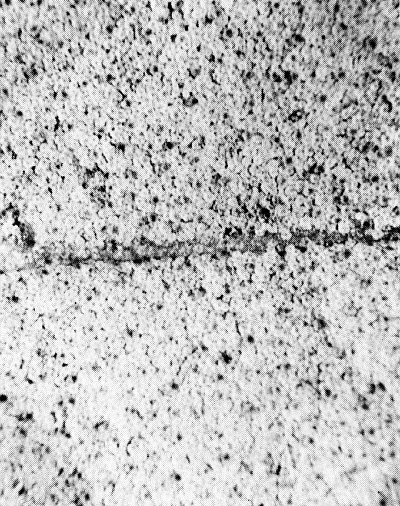
|
|
R. saluenense
Photo by Art Dome |
R. saluenense , s. Saluenense, Lepidote. "Very densely scaly below, the scales small and overlapping."
R. spinuliferum s. Scabrifolium, Lepidote. "Strongly reticulate below, softly pubescent and loosely glandular scaly."
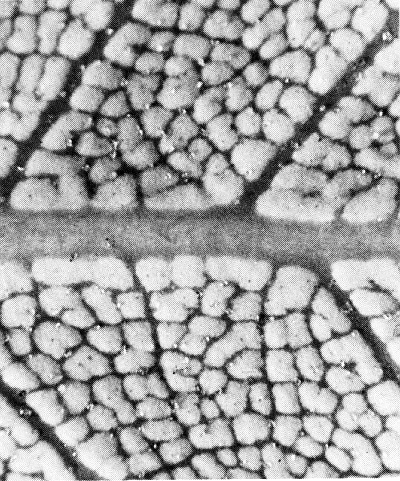
|
|
R. williamsianum
Photo by Art Dome |
R. williamsianum , s. Thomsonii, s.s. Williamsianum, Elepidote. "Undersurface glaucous, papillate, punctulate with small glands and hairs, midrib and primary veins and vein reticulations conspicuous."
R. lepidostylum , s. Trichoacdum, Lepidote. "Setulose on the margin, somewhat glaucous below and densely scaly, the scales not contiguous."
R. lutescens , s. Triflorum, s.s. Triflorum, Lepidote. "Pale green below with slightly impressed scales 2 to 3 times their own diameter apart."
R. yunnanense , s. Triflorum, s.s. Yunnanense, Lepidote.,,"Scaly above and below, the scales below about 2 to 4 times their own diameter apart, rather fleshy."
